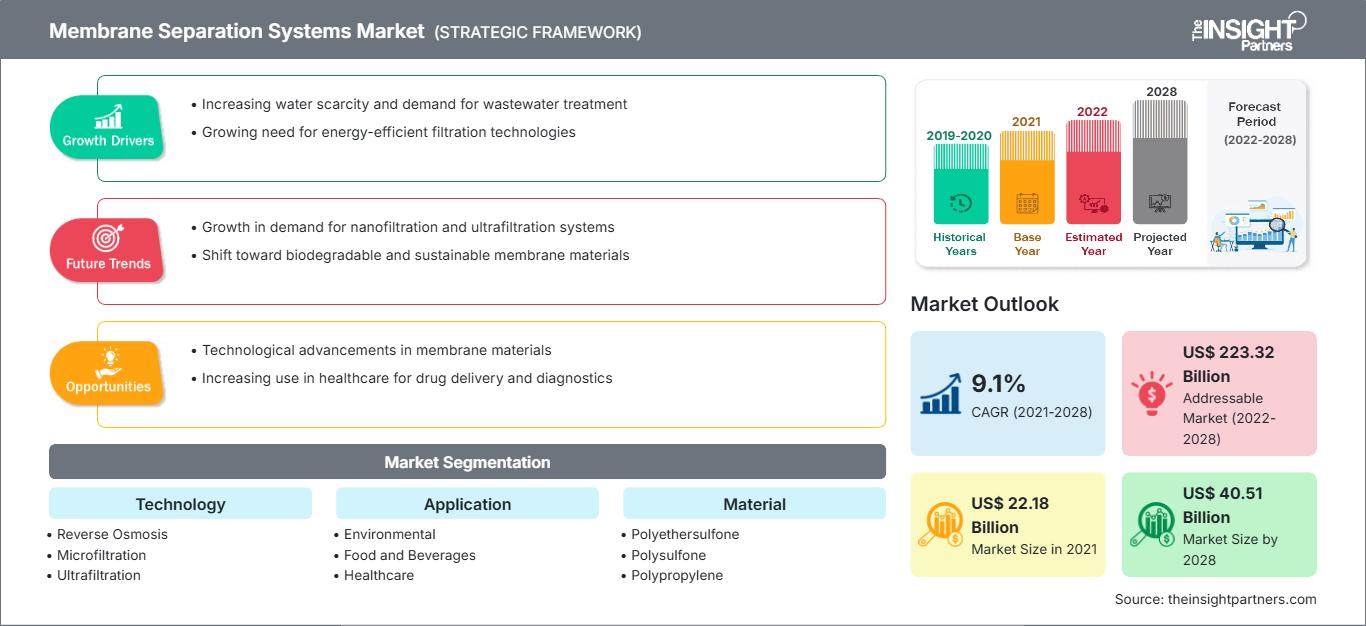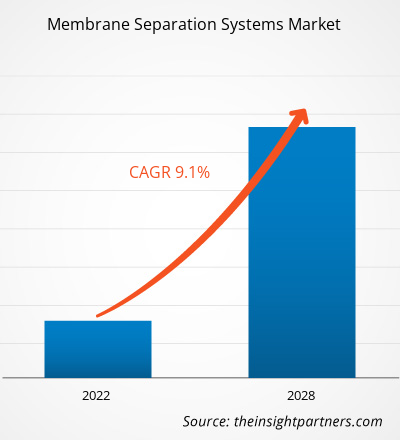Il mercato dei sistemi di separazione a membrana è stato valutato a 22.177,00 milioni di dollari nel 2021; si prevede una crescita a un CAGR del 9,1% dal 2022 al 2028.
I sistemi di separazione a membrana vengono utilizzati per separare diversi componenti di una soluzione in base alle loro dimensioni molecolari. Osmosi inversa, nanofiltrazione, ultrafiltrazione e microfiltrazione sono tipologie di tecniche di filtrazione a membrana, in ordine crescente di dimensione dei pori. L'ampio utilizzo dei sistemi di separazione a membrana nel trattamento delle acque reflue e un'ampia gamma di applicazioni nell'industria lattiero-casearia sono i principali fattori trainanti che alimentano il progresso del mercato. Tuttavia, la natura complessa di una tecnica di separazione a membrana ne ostacola la crescita.
Il mercato dei sistemi di separazione a membrana è stato analizzato in base a tecnologia, applicazione, materiale e area geografica. In termini geografici, il mercato è principalmente segmentato in Nord America, Europa, Asia-Pacifico, Medio Oriente e Africa e America meridionale e centrale. Il rapporto offre approfondimenti e analisi approfondite del mercato dei sistemi di separazione a membrana, sottolineando parametri quali tendenze di mercato, progressi tecnologici e dinamiche di mercato, nonché l'analisi del panorama competitivo dei principali attori del mercato.
Personalizza questo rapporto in base alle tue esigenze
Potrai personalizzare gratuitamente qualsiasi rapporto, comprese parti di questo rapporto, o analisi a livello di paese, pacchetto dati Excel, oltre a usufruire di grandi offerte e sconti per start-up e università
Mercato dei sistemi di separazione a membrana: Approfondimenti strategici

-
Ottieni le principali tendenze chiave del mercato di questo rapporto.Questo campione GRATUITO includerà l'analisi dei dati, che vanno dalle tendenze di mercato alle stime e alle previsioni.
Approfondimenti di mercato
L'ampio utilizzo nel trattamento delle acque reflue stimola la crescita del mercato dei sistemi di separazione a membrana
L'acqua pulita è essenziale per la sopravvivenza di ogni organismo vivente. Tuttavia, a causa del rapido aumento della popolazione e dell'industrializzazione, la domanda di acqua pulita, sicura e potabile è in forte aumento. La contaminazione dell'acqua da metalli pesanti, cianuri e coloranti è in aumento in tutto il mondo. Processi a membrana come la microfiltrazione (MF), l'ultrafiltrazione (UF), la nanofiltrazione (NF) e l'osmosi inversa (RO) sono ampiamente utilizzati per la filtrazione di acqua salmastra e di mare. Le membrane in ossido di grafene (GM) mostrano prestazioni promettenti nelle applicazioni di trattamento delle acque, come la desalinizzazione e il trattamento delle acque reflue. Si segnala che le membrane GM forniscono un'ampia gamma di flussi di acqua pura grazie alle loro proprietà idrofile, alla flessibilità e all'elevata resistenza meccanica, mentre le membrane UF e NF vengono utilizzate per la purificazione dei flussi di scarico ottenuti dal lavaggio dei letti filtranti utilizzati nei sistemi di trattamento delle acque delle piscine. I fatti sopra menzionati determinano il crescente utilizzo di sistemi di separazione a membrana per il trattamento delle acque reflue, indicando quindi una domanda in crescita.
Applicazione delle membrane
Approfondimenti basati sulla tecnologia
In base alla tecnologia, il mercato dei sistemi di separazione a membrana è suddiviso in microfiltrazione, ultrafiltrazione, nanofiltrazione, osmosi inversa, scambio ionico e altri. Il segmento dell'osmosi inversa ha detenuto la quota maggiore del mercato nel 2021 e si prevede che registrerà anche il CAGR più elevato durante il periodo di previsione. L'osmosi inversa offre il miglior livello di filtrazione nel trattamento delle acque. La membrana RO filtra tutti i sali e le molecole inorganiche e organiche con peso molecolare superiore a 100 kDa. Si tratta, quindi, di un processo altamente efficace per la rimozione di contaminanti come endotossine/pirogeni, insetticidi/pesticidi, erbicidi, antibiotici, nitrati, zuccheri, sali solubili e ioni metallici.
Approfondimenti basati sulle applicazioni
In base all'applicazione, il mercato dei sistemi di separazione a membrana è segmentato in settori ambientali, alimentari e delle bevande, sanitari e altri. Il segmento ambientale ha detenuto la quota di mercato maggiore nel 2021. Tuttavia, si prevede che il segmento sanitario registrerà il CAGR più elevato durante il periodo di previsione.
Approfondimenti basati sui materiali
In termini di materiali, il mercato dei sistemi di separazione a membrana è segmentato in polietersolfoni, polisolfoni, polivinilidenfluroide (PVDF), polipropilene (PP), poliacrilonitrile (PAN) e altri. Il segmento dei polietersolfoni ha detenuto la quota di mercato maggiore nel 2021 e si prevede che registrerà il CAGR più elevato durante il periodo di previsione.
Gli investimenti in nuovi impianti di trattamento delle acque reflue in molte micro, piccole e medie imprese/aziende hanno subito un rallentamento in tutto il mondo. Durante la pandemia di COVID-19, a causa di un calo dei loro ricavi, molte aziende che utilizzano acqua su larga scala hanno ridotto o ridimensionato le attività, con conseguente calo della domanda industriale di acqua. Inoltre, i lockdown e le restrizioni di viaggio hanno ulteriormente ostacolato la domanda da parte dei grandi utenti industriali e commerciali. Queste condizioni hanno portato a una diminuzione dei ricavi dei servizi idrici.
Le aziende del mercato dei sistemi di separazione a membrana adottano comunemente lanci di prodotti e strategie di espansione per espandere la propria presenza a livello mondiale e soddisfare la crescente domanda. La loro attenzione all'innovazione di prodotto consente loro di soddisfare le mutevoli esigenze dei clienti in tutto il mondo, il che consente loro anche di mantenere il proprio marchio a livello globale.
Nell'agosto 2022, Molnlycke, azienda leader mondiale nella produzione di prodotti e soluzioni medicali, ha annunciato due partnership storiche con Engie e Veolia, fornitori internazionali di soluzioni per la sostenibilità. L'azienda mira a fornire soluzioni di trattamento delle acque reflue all'avanguardia e a risparmio energetico per i suoi progetti in corso e futuri, in linea con il suo obiettivo di costruire un ecosistema produttivo sanitario sostenibile, rispondendo al contempo alle esigenze del mercato.
Nel dicembre 2020, DuPont Water Solutions, una business unit di DuPont Safety & Construction, ha lanciato TapTec Plus HF sul mercato indiano. DuPont TapTec Plus è compatibile con tutti i marchi di depuratori d'acqua residenziali e rappresenta la soluzione di purificazione definitiva per i consumatori più esigenti che cercano acqua pulita per la casa, con l'obiettivo a lungo termine di raggiungere una migliore qualità della vita.
Nell'aprile 2020, Koch Separation Solutions (KSS), leader mondiale nella tecnologia di filtrazione a membrana e scambio ionico, ha annunciato il suo piano di espandere del 50% la capacità produttiva della sua innovativa tecnologia a membrana a fibra cava rinforzata con PURON. Questa espansione produttiva riflette la significativa crescita di KSS e la sua maggiore capacità di servire rapidamente le aziende che utilizzano le sue tecnologie a membrana a fibra cava rinforzata per le loro esigenze di trattamento delle acque e delle acque reflue industriali e municipali.
In termini geografici, il mercato globale dei sistemi di separazione a membrana è segmentato in Nord America (Stati Uniti, Canada e Messico), Europa (Francia, Germania, Regno Unito, Spagna, Italia e resto d'Europa), Asia-Pacifico (Cina, India, Giappone, Australia, Corea del Sud e resto dell'APAC), Medio Oriente e Africa. Africa (Arabia Saudita, Emirati Arabi Uniti, Sud Africa e resto dell'area MEA) e America meridionale e centrale (Brasile, Argentina e resto dell'America meridionale e centrale).
Approfondimenti regionali sul mercato dei sistemi di separazione a membrana
Le tendenze regionali e i fattori che influenzano il mercato dei sistemi di separazione a membrana durante il periodo di previsione sono stati ampiamente spiegati dagli analisti di The Insight Partners. Questa sezione illustra anche i segmenti e la geografia del mercato dei sistemi di separazione a membrana in Nord America, Europa, Asia-Pacifico, Medio Oriente e Africa, America meridionale e centrale.
Ambito del rapporto di mercato sui sistemi di separazione a membrana
| Attributo del rapporto | Dettagli |
|---|---|
| Dimensioni del mercato in 2021 | US$ 22.18 Billion |
| Dimensioni del mercato per 2028 | US$ 40.51 Billion |
| CAGR globale (2021 - 2028) | 9.1% |
| Dati storici | 2019-2020 |
| Periodo di previsione | 2022-2028 |
| Segmenti coperti |
By Tecnologia
|
| Regioni e paesi coperti |
Nord America
|
| Leader di mercato e profili aziendali chiave |
|
Densità degli attori del mercato dei sistemi di separazione a membrana: comprendere il suo impatto sulle dinamiche aziendali
Il mercato dei sistemi di separazione a membrana è in rapida crescita, trainato dalla crescente domanda degli utenti finali, dovuta a fattori quali l'evoluzione delle preferenze dei consumatori, i progressi tecnologici e una maggiore consapevolezza dei vantaggi del prodotto. Con l'aumento della domanda, le aziende stanno ampliando la propria offerta, innovando per soddisfare le esigenze dei consumatori e sfruttando le tendenze emergenti, alimentando ulteriormente la crescita del mercato.

- Ottieni il Mercato dei sistemi di separazione a membrana Panoramica dei principali attori chiave
- 3M Co
- Koch Separation Systems Inc
- MANN+HUMMEL International GmbH & Co KG
- Pentair plc
- Hydranautics
- GEA Group AG
- DuPont de Nemours Inc
- Alfa Laval AB
- ProMinent GmbH
- Veolia Water Technologies SASU
- Analisi storica (2 anni), anno base, previsione (7 anni) con CAGR
- Analisi PEST e SWOT
- Valore/volume delle dimensioni del mercato - Globale, Regionale, Nazionale
- Industria e panorama competitivo
- Set di dati Excel
Report recenti
Testimonianze
Motivo dell'acquisto
- Processo decisionale informato
- Comprensione delle dinamiche di mercato
- Analisi competitiva
- Analisi dei clienti
- Previsioni di mercato
- Mitigazione del rischio
- Pianificazione strategica
- Giustificazione degli investimenti
- Identificazione dei mercati emergenti
- Miglioramento delle strategie di marketing
- Aumento dell'efficienza operativa
- Allineamento alle tendenze normative






















 Ottieni un campione gratuito per - Mercato dei sistemi di separazione a membrana
Ottieni un campione gratuito per - Mercato dei sistemi di separazione a membrana